by Laurie Osgood | Oct 26, 2017
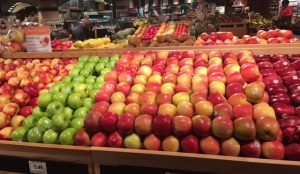
Apples are an ancient fruit, grown for thousands of years, and belong to the Rose family of plants. The Rose family also includes plums, raspberries, cherries, peaches, pears, and almonds.
According to Professor Peter C. Andersen, UF/IFAS Horticultural Sciences Department at the North Florida Research and Education Center in Quincy, the basics of apple growing haven´t changed much over the centuries. Although many homeowners in north Florida can grow apple trees, there is little potential for establishment of commercial apple orchards in Florida. Andersen says apples are difficult to grow in north Florida due to high rainfall, humidity, and insects during the apple-ripening season, which is late May through August. Apples need a chill period in order to set buds in the spring. Without a sufficient chill period, the apple tree will not cultivate. For more information on Florida apple varieties, check out Low-Chill Apple Cultivars for North Florida and North Central Florida.
Luckily, there are more than 8,000 varieties of apples grown worldwide, so you can still enjoy a selection of apples in north Florida, even if you aren’t able to grow them yourself.
Fun Apple Facts:
- Apples are very nutritious, especially when you eat the whole apple. The majority of the apple’s nutrients are in its skin.
- Apples are a good source of fiber and vitamin C and do not contain sodium, fat, or cholesterol.
- Apples ripen much faster at room temperature than if they are refrigerated.
- It takes about 36 apples to create one gallon of apple cider.
Apple Varieties:
Every type of apple has a distinct color, texture, and taste. There are more than 8,000 variations of apples grown worldwide. Here are some of the more well-known apples that are grown in the United States:
| Red Delicious |
This apple is grown in Iowa and is known for its deep red color and mild sweetness. The Red Delicious apple is finest when eaten whole or chopped up into salads. |
| Granny Smith |
This variety has a thick, green exterior with a sour taste. It is firm, crisp, and juicy inside and is best used for baking into pies and other baked goods. |
| Gala |
This variety has a waxy red and yellow skin with a golden interior. Its tart taste is ideal for baking or just eating. |
| McIntosh |
This apple grows abundantly in New England. McIntosh apples are crisp and juicy at their peak, but tend to soften quickly. This variety can be eaten off the tree or made into apple cider. |
| Golden Delicious |
This variety has a soft yellow skin and sweet flavor. This is considered an all-purpose apple that is ideal for snacking and cooking. |
| Empire: |
Empire apples are named for its home state of New York and is a mixture of a red delicious and a McIntosh apple. The Empire apple is crunchy and has a sweet taste, however, its texture changes quickly with extended storage, so it’s best eaten at its peak of freshness. |
Cooper, Emily. “Apples, a Bushel and a Peak of Flavor.” Food and Nutrition, 2017, pp. 28–29.
There are many other varieties of apples, and all are incredibly good for you. For the greatest benefits, eat the whole fruit — both skin and flesh.
To learn more about apples and their health benefits and healthy eating, please visit UF/IFAS Extension Solutions for Your Life or the USDA SNAP-Ed Connection.
by Laurie Osgood | Dec 3, 2016
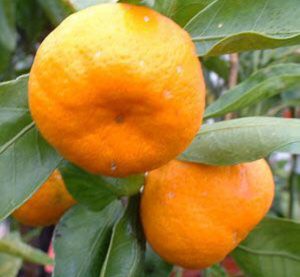 It’s the fall season, and Satsumas are hitting the shelves at your local grocery store. Satsumas are a seedless variety of the mandarin orange, and are harvested during the fall and early winter. Satsumas are grown in the cool, sub-tropical areas of California, Florida, Alabama, Louisiana, Mississippi and Texas. Because of their thin skin, satsumas are sweet and easy to peel. Whether you are buying satsumas from your local grocery store, farmers market or roadside stand, it is very important to purchase all of your citrus from a reputable vendor.
It’s the fall season, and Satsumas are hitting the shelves at your local grocery store. Satsumas are a seedless variety of the mandarin orange, and are harvested during the fall and early winter. Satsumas are grown in the cool, sub-tropical areas of California, Florida, Alabama, Louisiana, Mississippi and Texas. Because of their thin skin, satsumas are sweet and easy to peel. Whether you are buying satsumas from your local grocery store, farmers market or roadside stand, it is very important to purchase all of your citrus from a reputable vendor.
Satsuma Trees:
Satsuma trees are small to medium in size, and can easily tolerate the cooler fall temperatures that the Florida Panhandle is known for. Satsuma trees are relatively easy to grow and make an attractive addition to your home landscape. Picking fresh fruit off of your own tree provides a much fresher, and cost efficient treat. Satsuma trees are best started in a container and then transferred into the ground. When choosing a spot to plant a satsuma tree, remember that citrus trees need full sun.
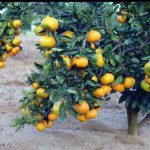 “Before planting any new plants, you should always conduct a soil sample, to determine if there are any issues in the soil where you will plan the satsuma tree” said DJ Wiggin, Small Farms Agent with the Florida A&M University Extension Program in Gadsden County. If you would like to request a soil sample test kit, you should contact your local UF/IFAS Extension office.
“Before planting any new plants, you should always conduct a soil sample, to determine if there are any issues in the soil where you will plan the satsuma tree” said DJ Wiggin, Small Farms Agent with the Florida A&M University Extension Program in Gadsden County. If you would like to request a soil sample test kit, you should contact your local UF/IFAS Extension office.
Fruit Bearing Season:
Satsuma oranges have a relatively brief fruit bearing season, between October and December. This short season give the satsuma oranges their rich flavor. A few nights with temperatures that drop into the 40s, help improve their sweetness. However, the fruit of the satsuma tree should be picked promptly when ripe, because the heavy fruit could cause damage to some weaker limbs of the tree.
According to DJ Wiggins, “When properly stored, satsumas have a shelf life of several weeks”. Satsuma oranges can be juiced, eaten as a snack, or used in recipes, including Orange marmalade.
Recipe Source: Adapted from So Easy to Preserve, from the Cooperative Extension at The University of Georgia.
Orange Marmalade
Yields about 7 half-pint jars
• 4 cups thinly slices Orange Peel (about 6 large oranges or 32 Satsumas)
• 4 cups Orange Pulp, cut up (about 6 large oranges or 32 Satsumas)
• 1 thinly sliced Lemon (about 2 medium)
• 6 cups of Water
• Sugar (about 6 cups)
Directions:
To Prepare the Fruit- Add water and fruit together in a saucepan. Heat to simmer for 5 minutes. Cover and let stand 12 to 18 hours in refrigerator. Heat and cook over medium heat until peel is tender, about 1 hour. (Note: When peeling citrus fruits for marmalades, be sure to include some of the white membrane found just under the skin. This is where most of the pectin is located.)
To Make Marmalade– Sterilize canning jars. Measure fruit and liquid. Add 1 cup sugar for each cup of fruit mixture. Bring slowly to boil, stirring until sugar dissolves. Cook rapidly to the jellying point (25 minutes), stirring occasionally. Pour hot marmalade into hot, sterile ½ pint jars, leaving ¼ inch headspace. Wipe jar rims with a dampened clean paper towel and adjust lids. Process 5 minutes in a Boiling Water Canner.
Interested in Learning More about Canning Fruits and Vegetables? The Gadsden County Extension Program offers Water Bath Canning Classes throughout the year, to learn more, call us at (850) 875-7255.
Resources:
University of Florida IFAS Extension. The Satsuma Mandarin, Peter C. Andersen and James J. Ferguson, Revised November 2015
http://edis.ifas.ufl.edu/pdffiles/CH/CH11600.pdf
University of Alabama Extension, Satsuma Season: Enjoying the Christmas Orange, James Miles and Emma Sager, November 10, 2014
http://news.aces.edu/blog/2014/11/10/satsumaseason/
University of Georgia Extension: Citrus Fruit for Southern and Coastal Georgia, Krewer and Powell, Extension Fruit Specialists.
http://extension.uga.edu/publications/detail.cfm?number=B804
Recipe: Reynolds, Susan, Paulette Williams, Judy A. Harrison, and Susan J. Reynolds. So Easy to Preserve. Athens: Cooperative Extension Service, U of Georgia, College of Family and Consumer Sciences, College of Agricultural and Environmental Sciences, 2006. Page 218
The Institute of Food and Agricultural Sciences (IFAS) is an Equal Opportunity Institution authorized to provide research, educational information and other services only to individuals and institutions that function with non-discrimination with respect to race, creed, color, religion, age, disability, sex, sexual orientation, marital status, national origin, political opinions or affiliations. For more information on obtaining other UF/IFAS Extension publications, contact your county’s UF/IFAS Extension office.
U.S. Department of Agriculture, UF/IFAS Extension Service, University of Florida, IFAS, Florida A & M University Cooperative Extension Program, and Boards of County Commissioners Cooperating. Nick T. Place, dean for UF/IFAS Extension.
Coauthors:
Laurie Osgood, Family and Consumer Science Agent, UF/IFAS Extension, Gadsden County
DJ Wiggins, Small Farms Agent, Florida A&M University Extension, Gadsden County
by Heidi Copeland | Sep 27, 2016
Autumn, which technically started on the 22nd day of September is a good time to FALL back into good nutrition!
Many Florida crops are in season now. According to the Florida Department of Agriculture and Consumer Services (FDACS); avocados, bell peppers, carambolas, cucumbers, grapefruits, guavas, mushrooms, oranges, peanuts, squash, sweet corn, tangerines and tomatoes are Fresh From Florida® this month. Additionally, our local Red Hills Small Farm Alliance’s seasonal produce includes elephant garlic, lemon grass, shiitake mushrooms and ginger root.
As the temperatures begin to drop, the days continue to get shorter, and the produce of autumn starts to appear, take time to incorporate that produce into your daily diets. Try celebrating October with a delicious, quick to prepare Roasted Vegetable Pasta recipe. Alice Henneman, Extension Educator Southeast Research & Extension Center University of Nebraska Lincoln writes a wonderful blog including recipes and tips with the goal of making you hungry for healthy food! You’ll enjoy this recipe so much you will want to make it again and again with whatever is in season!
Roasted Vegetable Pasta
Servings: 4 side dish or 2 large main dish servings
Exact amounts aren’t needed in this recipe. Just keep the vegetables being roasted at one time to an amount that can be spread in a single, even layer on a pan in the oven.
Ingredients
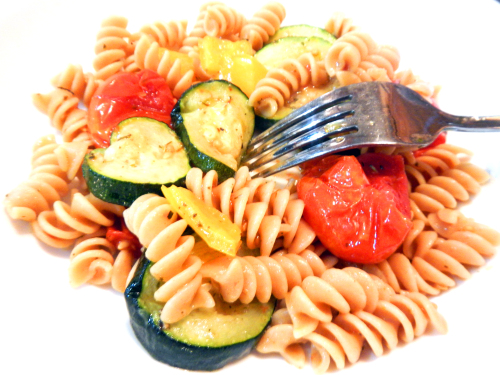 2 to 4 cups cherry tomatoes, left whole with skins
2 to 4 cups cherry tomatoes, left whole with skins- One large bell pepper (any color), cut into 1-inch pieces
- 1 to 2 medium zucchini, cut into 1/4-inch slices
- 3 tablespoons extra virgin olive oil
- 1 teaspoon Italian seasoning
- 8 ounces uncooked pasta (preferably whole grain), such as rotini, farfalle (bow tie shaped) or medium-sized shell pasta
- Salt and pepper (preferably fresh ground pepper) to taste
- Grated Parmesan cheese, preferably freshly grated (optional)
Directions
- Preheat oven to 375 degrees F.
- Mix together cherry tomatoes, bell pepper slices, zucchini and extra virgin olive oil in a large roasting pan, a 9 x 13-inch baking pan or a baking sheet with sides. Spread the vegetables in a single, even layer on the pan. Use a larger pan or a couple of pans if necessary to prevent stacking the vegetables.
- Sprinkle the Italian seasoning over the vegetables.
- Roast for 25 to 35 minutes, until the tomatoes and zucchini are softened and the pepper has started to brown.
- Meanwhile, cook the pasta according package directions. Drain, reserving about 1/2 cup of the pasta water.
- Combine the roasted vegetables with the pasta in a large mixing bowl. Season to taste with salt and pepper. If needed, add reserved cooking liquid by the tablespoonful until you have added enough liquid if pasta requires additional moistening.
- Transfer to a serving dish. Serve and pass the grated Parmesan if desired.
Alice’s Tips
- If you decide to use the recipe for 2 main-dish servings, include the cheese to add some protein to the meal. Or, you might quickly heat some pre-cooked shrimp according to package directions and add to the pasta dish.
Used with permission from: Alice Henneman, MS, RDN, University of Nebraska–Lincoln Extension Educator. For more recipes and tips for fast, healthy and delicious foods, visit https://cookitquick.org/
by Heidi Copeland | Aug 28, 2016
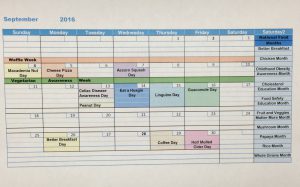
The University of Nebraska – Lincoln (UNL) provides a monthly Calendar of Food Days, Weeks, and Months plus provides resources for selected national food-themes. http://food.unl.edu/september-food-calendar
The month of September boasts a variety of activities using produce that can be grown somewhere in Florida. In fact, many crops are grown locally and are in season now. According to the Florida Department of Agriculture and Consumer Services (FDACS), avocados, carambolas, grapefruits, guavas, mushrooms, oranges, peanuts, and tangerines are Fresh From Florida® this month. http://www.freshfromflorida.com/content/download/16800/269959/09September.pdf In addition, local Red Hills Small Farm Alliance’s seasonal produce includes arugula, Asian greens, eggplant, garlic, okra, southern peas, peppers, radishes, summer and winter squash, figs, Muscadine grapes, pears, and persimmons.
It is easy to incorporate more fruits and vegetables into our diets. Try celebrating September with Vegetarian Awareness Week and consume any of the aforementioned produce, as well as peanuts on National Peanut Day, which is on September 13th.
Peanuts are actually legumes, and can easily fit into many meal plans. Additionally, they are considered a quality protein source for vegetarians. And, according to the Peanut Institute “While ‘nut’ is in their name, peanuts actually grow underground, as opposed to nuts like walnuts, almonds, etc. that grow on trees and are sometimes referred to as tree nuts”.
Peanuts, along with beans and peas, belong to the single plant family, Leguminosae. Leguminosae, commonly referred to as legumes are edible seeds that are enclosed in pods. These plants provide an excellent source of concentrated protein plus, peanuts are rich in vitamins, minerals and phytonutrients, and contain mostly good fats and fiber.
It is fun (and healthy) to experiment with local, fresh Florida produce anytime of the year, and why not have a delicious time this September celebrating a food recognition day, a food awareness week or even an entire month by incorporating Florida fresh foods into your daily, weekly, and monthly meals?
Below is a recipe for a savory peanut sauce, which is very versatile for vegetarian meals and meals with meat or fish. Some ideas for using peanut sauce include:
- Over noodles
- As a dipping sauce for vegetables or spring rolls
- As a baste or condiment for chicken, pork, beef , fish or tofu
- In a stir fry
- In a wrap
- In a slaw
INGREDIENTS
- ¾ cup creamy peanut butter
- ¼ cup rice vinegar
- ¼ cup water
- ⅓ cup reduced sodium tamari or reduced-sodium soy sauce
- 3 tablespoons honey or agave nectar
- 1½ teaspoons grated fresh ginger or ½ teaspoon ground ginger
- 1 to 2 medium cloves garlic, pressed or minced, to taste
- ¼ teaspoon red pepper flakes, plus more for sprinkling
- Optional garnishes: sprinkling of chopped roasted peanuts and additional red pepper flakes
- INSTRUCTIONS
- In a 2-cup liquid measuring cup or medium-sized mixing bowl, whisk together the ingredients until well blended. If your peanut butter is particularly thick, you may need to add a bit more water to thin out the mixture (adding water will mellow out the flavor as well).
- Feel free to adjust to taste here—for example, sometimes I want my sauce more savory and add another clove of garlic, or a little sweeter, so I add extra honey.
- If you’re serving the sauce as a party dip, transfer it to a serving bowl and sprinkle with chopped peanuts and red pepper flakes for some visual interest!
by Heidi Copeland | Jun 12, 2016
What’s in season now? Although summer doesn’t officially start for a few more weeks farmers have been busy producing seasonal, summer fruits and vegetables. The seasonal vegetable guide for North Florida Produce has an abundance! Not only are basil and beans plentiful, so are blackberries, blueberries and mulberries, corn, cucumbers, eggplant, garlic, melons, okra, peas (southern) peppers, summer squash, and tomatoes. (in the southern part of Florida avocado, guava, lychee, mango, papaya, and passion fruit are showing up)
Fruits and vegetables are loaded with great vitamins and minerals! And eating at least 3-5 servings a day of fruits and vegetables is truly considered the key to good health. Folks who eat a wide variety of colors – both fruits and vegetables, as part of an overall healthy diet, are likely to have a reduced risk of some chronic diseases. Both fruits and vegetables provide nutrients vital for health and maintenance of your body.
Eating fruits and vegetables is easy to do!
Have you ever tried using the United States Department of Agriculture What’s Cooking? USDA Mixing Bowl recipe finder? Using this website, I simply checked the box that I’d like to focus on, eating more fruit and vegetables then added the ingredient zucchini to the recipe search box. http://whatscooking.fns.usda.gov/ 
Sixty recipes popped up! I choose the one for Squash Squares.
Squash Squares: Ingredients
4 eggs (beaten lightly)
1/4 cup oil
3 cups thinly sliced squash (use zucchini or yellow squash)
1/4 cup chopped onion
1 cup biscuit mix
1 teaspoon dried parsley (or 2 T chopped fresh parsley)
1/3 cup grated cheddar cheese
1 cup grated carrots
Directions
- Mix all ingredients thoroughly and pour into a greased 9×13″ baking dish.
2. Bake 25 minutes, or until bubbly and brown, in a 350°F oven.
3. Serve in squares while warm.
Notes
- To freeze – Cool, and cut into squares. Freeze squares on a cookie sheet. When they are frozen, put into freezer bags. When ready to use, take out of the freezer bag, place in microwaveable covered container. Reheat in microwave at medium setting.
- Try 8 egg whites in place of whole egg for less cholesterol and fat.
- Add other thinly chopped fresh veggies into the mix – green or red sweet peppers, spinach, broccoli.
I’ve tried this recipe using both yellow squash and zucchini with equally tasty results. I especially appreciated the suggestions on the recipe to personalize by adding your own twist. Like it spicy? Add a jalapeno! Want to add some pizzazz? Add some diced red pepper for color. Want to eat it later? Just freeze and eat or reheat and eat! Don’t have zucchini on hand? Substitute other thinly chopped fresh veggies. I have even substituted the biscuit mix with a corn bread mix for yet another spin.
Fruits and vegetables are nutritious and delicious. Try adding some Florida fresh, seasonal fruits and vegetables to your meals!






